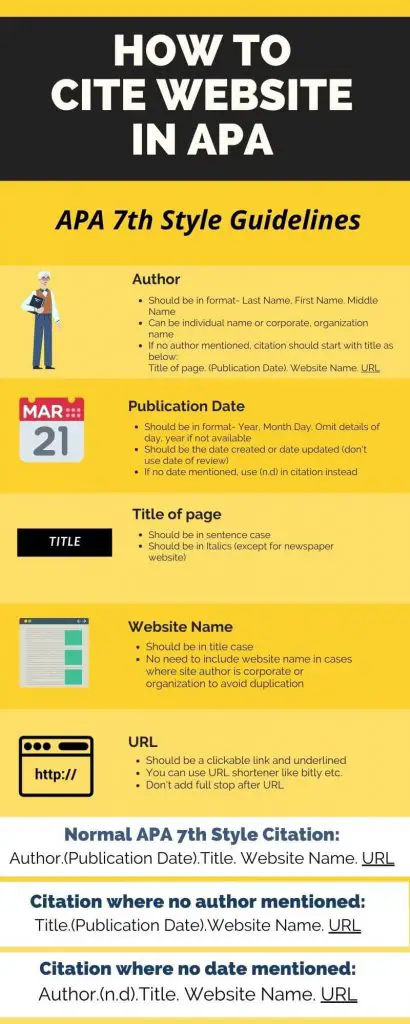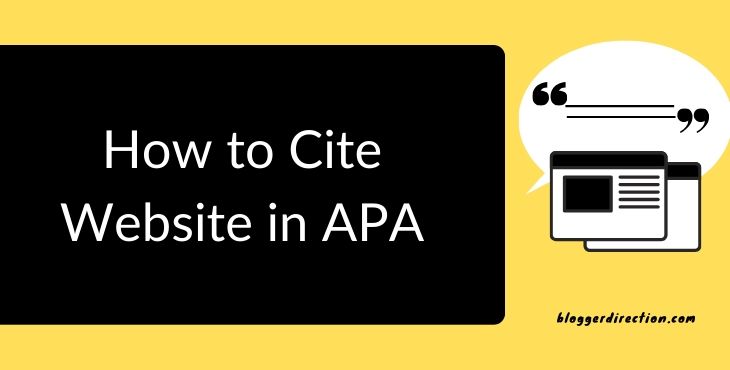When you use a website for your academic research, many times you will have to cite the website reference in APA style. And often there are a lot of challenges in getting this right, due to missing information like no author or no date available. This complete guide will help you to cite a website in APA with some useful tips.
Citation is a way of giving credit to the source of information i.e. author or publication. Citation guidelines like APA or MLA help to present the source information in a consistent and structured format.
The APA (American Psychological Association) style of referencing is a widely used way of citing the source of information in academic documents like journals and research papers.
APA style guidelines also get updated from time to time, although not that frequently. The last update i.e. APA 7th edition was introduced by APA in October 2019. It replaces the APA 6th edition which was introduced way back in July 2009.
For this post, we will use the latest APA 7th edition guidelines. With that context, let’s now answer the core question on how to cite websites using APA style.
How to cite a website in APA? To cite a website in APA style, you need to mention the webpage elements in the following format : Author. (Publication Date). Title of web-page. Website Name. URL
Now before we jump further into details, an important point to note here is that not all online content is a website. APA style also has different citation guidelines for News websites which in addition to offering articles online have their print version such as The New York Times or The Washington Post. Also, there are separate formats for other types of online content like journals, research papers etc. You can also check the detailed guidelines for all types of citations in APA manual (available on Amazon).
So coming back to our main topic -citation of website. We require information on 5 key elements to properly cite the source content.
These five key elements need to be mentioned while referencing any website in APA style. The elements need to be separated by a period i.e. a full stop. These elements are-
- Author
- Publication Date
- Title of Page
- Website Name (also called Source Element)
- Website URL
Let’s see this in more detail- what are the expected formats, where can we find this information and more important-how to cite if we don’t find information on any of these elements.
1. Author
The author of content is the first element to be quoted in APA style citation. There are some specific guidelines on how you can format the name of the author.
If the article is written by an individual author, mention the last name of the author, followed by the first and middle initial (if available).
Author’s Last Name. First Initial. Middle Initial (if Given).
e.g. Hardy, K.
If a surname or last name is hyphenated, just mention the hyphenated name as is.
Also, if an author has two names as their surname, include both names.
What if there is no author mentioned?
It can often be difficult to find the author of the webpage. It is important to note that the author can also be a corporation or group, not only a specific person.
For example- If you refer to a page on a government website or an organization’s website WITHOUT individual authors, use the name of the government agency or organisation responsible for the webpage as the author.
In the example below- National Institute of Mental Health is the government agency or organisation that can be taken as the author.
National Institute of Mental Health. (2018, July). Anxiety disorders. U.S. Department of Health and Human Services, National Institutes of Health.
https://www.nimh.nih.gov/health/topics/anxiety-disorders/index.shtml
If the author of the content is mentioned to be ‘Anonymous,’ then use the word “Anonymous” as the author’s name.
In some cases, you may also find the Author information in the “About Us” or “Author” section on a website.
What if the author can still not be identified?
If you still can’t identify the author even after all attempts, you can omit this element altogether. In such cases, start the citation with the title followed by the publication date and other elements.
Title of page. (Publication Date). Website Name. URL
2. Publication Date
Publication date needs to be entered in the below format with parenthesis-
(Year, Month Day)
e.g.
(2019, December 29)
NOTE: Publication date is the date when the webpage was created or it was last updated. Usually, it is mentioned below the title of the article. Sometimes, you may find it on the footer or bottom of the webpage.
However, note that this should not be confused with the Copyright date for the website which is usually just the year. In the case of a newspaper website, provide the specific date the story was published.
Provide a specific date to the extent possible for the webpage. In case you are not able to find the complete date, mention the information to the extent available say only the year or year and month etc.
Some online sources mention the date when the content was last updated. You can mention the updated date in the citation if this date applies to the specific content you are citing and not if it is just for the overall website
Also, you need to ignore the date of the last review (if mentioned) for the purpose of reference. For the simple reason- if content has been reviewed, it does not mean it was changed or updated.
What if there is no date available?
If the publication date is not available or cannot be identified, then use the abbreviation “n.d.” with parenthesis in the citation- which stands for no date . Format as below-
Author. (n.d.). Title of page. Website name. URL
3. Title of Web-page
Next important element is the title or heading of the article.
Article title needs to mentioned in Sentence Case and in Italics
Sentence case is the normal way of using capital letters i.e. capitalizing only the first word and any proper nouns in a sentence.
If the website has a print version like in case of newspaper website, then you DON’T need to italicise.
4. Website Name
Website Name needs to mentioned in Title case.
Title case means that the first letter of each word is capitalized, except for certain small words, such as articles and short prepositions.
The names of parent agencies not present in the author element can appear in the source element (in the example, the U.S. Department of Health and Human Services, National Institutes of Health).
National Institute of Mental Health. (2018, July). Anxiety disorders. U.S. Department of Health and Human Services, National Institutes of Health.
https://www.nimh.nih.gov/health/topics/anxiety-disorders/index.shtml
You must include the site name in your citation unless its a corporate or organisation website where the website name is the same as the author, to avoid repetition. In the example below, the name of the organisation is omitted from the source element to avoid repetition.
World Health Organization. (2018, May 24). The top 10 causes of death.
https://www.who.int/news-room/fact-sheets/detail/the-top-10-causes-of-death
5. URL
Last comes the URL.
This needs to be in the form of a clickable hyperlink.
You can also use a URL-shortening service if the link is too long and doesn’t look good on the eyes. Some URL Shortner websites that you can use for this purpose:
It is important to note that you DON’T add a full stop or period after the URL.
URLs are no longer preceded by “Retrieved from,” unless a retrieval date is needed. This was the requirement earlier in APA 6th style.
Now it is applied only in case of certain websites, only when needed.
For e.g- In the case of websites, where the information is subject to frequent change, you also need to mention the date when you retrieved the information in the format “Retrieved date from” before the URL- See example below
U.S. Census Bureau. (n.d.). U.S. and world population clock. U.S. Department of Commerce. Retrieved January 9, 2020, from https://www.census.gov/popclock/

Some Helpful Videos on APA Style Referencing
Types of Citations- In-Text vs References
Citations are usually of 2 types i.e. In-Text or in References
In-text/Parenthetical citations:
- Citations included in the body of a project
- Added when using a direct quote or paraphrase from a source
- Generally contain the name(s) of the author(s), date, and page number(s), if applicable
References:
- Citations included in the final part of a project
- Included in the reference list (sometimes called APA works cited by some teachers) at the end of the assignment.
- Contains the complete list of all sources used in a project
- References contain the author’s name, date published, title, publisher, URL, and other key pieces of information.
Examples of APA style referencing
Example 1- Citation of webpage from a News website
Gallagher, J. (2015, November 1). Antibiotic apocalypse. BBC News.
http://www.bbc.com/news/health-21702647
2. Example – Citation of web-page on a website with a government agency group author
National Institute of Mental Health. (2018, July). Anxiety disorders. U.S. Department of Health and Human Services, National Institutes of Health.
https://www.nimh.nih.gov/health/topics/anxiety-disorders/index.shtml
- Parenthetical citation: (National Institute of Mental Health, 2018)
- Narrative citation: National Institute of Mental Health (2018)
3. Example- Citation of web-page of a website with an organizational group author
World Health Organization. (2018, May 24). The top 10 causes of death. https://www.who.int/news-room/fact-sheets/detail/the-top-10-causes-of-death
Center for Disease Control and Prevention. (2018, January 23). People at high risk of developing flu-related complications. https://www.cdc.gov/flu/about/disease/high_risk.htm
4. Example – Citation of web-page with an individual author
Giovanetti, F. (2019, November 16). Why we are so obsessed with personality types. Medium. https://medium.com/the-business-of-wellness/why-we-are-so-obsessed-with-personality-types-577450f9aee9
Chi, C. (2018, July 30). 4 management styles to strive for, and 4 to avoid. HubSpot.
https://blog.hubspot.com/marketing/management-styles
5. Webpage on a website with a retrieval date
When contents of a page are designed to change over time but are not archived, include a retrieval date in the reference.
U.S. Census Bureau. (n.d.). U.S. and world population clock. U.S. Department of Commerce. Retrieved January 9, 2020, from https://www.census.gov/popclock/

